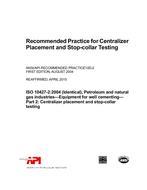No products
 View larger
View larger
API RP 10D-2 (R2020)
M00043774
New product
API RP 10D-2 (R2020) Recommended Practice for Centralizer Placement and Stop Collar Testing, First Edition
standard by American Petroleum Institute, 08/01/2004
Full Description
Provides calculations for determining centralizer spacing, based on centralizer performance and desired standoff, in deviated and dogleg holes in wells for the petroleum and natural gas industries. It also provides a procedure for testing stop collars and reporting test results.
This edition of API RP 10D-2 is the identical national adoption of ISO 10427-2, Petroleum and natural gas industries-Equipment for well cementing-Part 2: Centralizer placement and stop-collar testing
In stock
More info
Recommended Practice for Centralizer Placement and Stop-collar Testing
ANSI/API RECOMMENDED PRACTICE10D-2 FIRST EDITION, AUGUST 2004
REAFFIRMED, JANUARY 2020
ISO 10427-2:2004 (Identical), Petroleum and natural gas industries—Equipment for well cementing— Part 2: Centralizer placement and stop-collar testing
Special Notes
API publications necessarily address problems of a general nature. With respect to particular circumstances, local, state, and federal laws and regulations should be reviewed.
API is not undertaking to meet the duties of employers, manufacturers, or suppliers to warn and properly train and equip their employees, and others exposed, concerning health and safety risks and precautions, nor undertaking their obligations under local, state, or federal laws.
Information concerning safety and health risks and proper precautions with respect to particular materials and conditions should be obtained from the employer, the manufacturer or supplier of that material, or the material safety data sheet.
Nothing contained in any API publication is to be construed as granting any right, by implication or otherwise, for the manufacture, sale, or use of any method, apparatus, or product covered by letters patent. Neither should anything contained in the publication be construed as insuring anyone against liability for infringement of letters patent.
Generally, API standards are reviewed and revised, reaffirmed, or withdrawn at least every five years. Sometimes a one-time extension of up to two years will be added to this review cycle. This publication will no longer be in effect five years after its publication date as an operative API standard or, where an extension has been granted, upon republication. Status of the publication can be ascertained from the API Standards department telephone (202) 682-8000. A catalog of API publications, programs and services is published annually and updated biannually by API, and available through Global Engineering Documents, 15 Inverness Way East, M/S C303B, Englewood, CO 80112-5776.
This document was produced under API standardization procedures that ensure appropriate notification and participation in the developmental process and is designated as an API standard. Questions concerning the interpretation of the content of this standard or comments and questions concerning the procedures under which this standard was developed should be directed in writing to the Director of the Standards department, American Petroleum Institute, 1220 L Street, N.W., Washington, D.C. 20005. Requests for permission to reproduce or translate all or any part of the material published herein should be addressed to the Director, Business Services.
API standards are published to facilitate the broad availability of proven, sound engineering and operating practices. These standards are not intended to obviate the need for applying sound engineering judgment regarding when and where these standards should be utilized. The formulation and publication of API standards is not intended in any way to inhibit anyone from using any other practices.
Any manufacturer marking equipment or materials in conformance with the marking requirements of an API standard is solely responsible for complying with all the applicable requirements of that standard. API does not represent, warrant, or guarantee that such products do in fact conform to the applicable API standard.
These materials are subject to copyright claims of ISO, ANSI and API.
All rights reserved. No part of this work may be reproduced, stored in a retrieval system, or transmitted by any means, electronic, mechanical, photocopying, recording, or otherwise, without prior written permission from the publisher. Contact the Publisher, API Publishing Services, 1220 L Street, N.W., Washington, D.C. 20005.
Copyright © 2004 American Petroleum Institute
API Recommended Practice 10D-2 / ISO 10427-2
API Foreword
This standard shall become effective on the date printed on the cover but may be used voluntarily from the date of distribution.
API publications may be used by anyone desiring to do so. Every effort has been made by the Institute to assure the accuracy and reliability of the data contained in them; however, the Institute makes no representation, warranty, or guarantee in connection with this publication and hereby expressly disclaims any liability or responsibility for loss or damage resulting from its use or for the violation of any federal, state, or municipal regulation with which this publication may conflict.
Standards referenced herein may be replaced by other international or national standards that can be shown to meet or exceed the requirements of the referenced standard.
Suggested revisions are invited and should be submitted to the API, Standards Department, 1220 L Street, NW, Washington, DC 20005, or by email to standards@api.org.
The form in this annex is intended for free exchange between owners/operators of the equipment or users of API RP 10D-2.
This American National Standard is under the jurisdiction of the API Subcommittee on Well Cements, SC10. This standard is considered identical to the English version of ISO 10427-2. ISO 10427-2 was prepared by Technical Committee ISO/TC 67 Materials, equipment and offshore structures for petroleum and natural gas industries, SC 3 Drilling and completion fluids, and well cements.
ii
API Recommended Practice 10D-2 / ISO 10427-2
Contents
Page
API Foreword ii
Foreword iv
Introduction v
Scope 1
Normative references 1
Terms and definitions 1
Methods for estimating centralizer placement 3
General 3
Standoff ratio calculation 4
Buoyed weight of casing 5
Calculations for centralizer spacing 6
Procedure for testing stop collars 9
General 9
Apparatus 10
Test procedure 11
Reporting of test results 11
Annex A (informative) Documentation of stop-collar test results 12
Bibliography 14
iii

